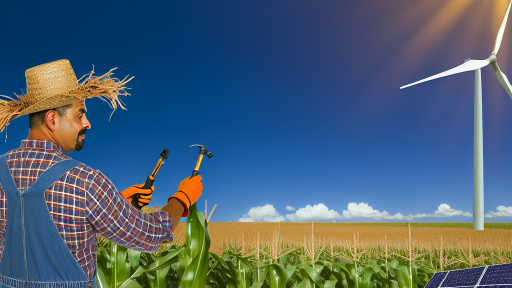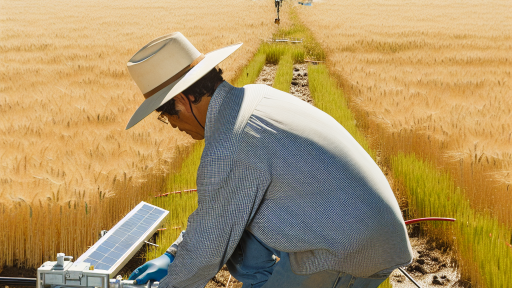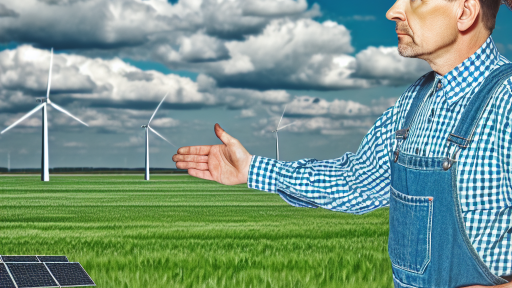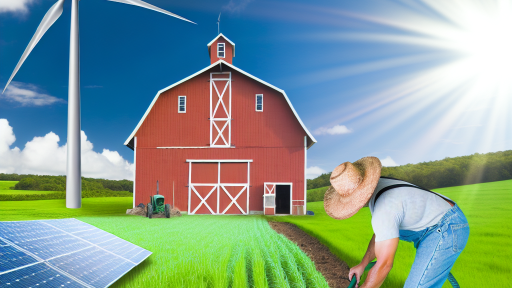Introduction to Wind Energy and Its Relevance in Modern Agriculture
Wind energy plays a crucial role in modern farming practices.
This renewable resource helps farmers reduce their carbon footprint.
Wind power offers a sustainable solution for energy needs.
Farmers can harness wind energy to power their operations.
This reduces reliance on fossil fuels and lowers energy costs.
Additionally, wind energy can contribute to energy independence.
Incorporating wind turbines into agricultural settings is beneficial.
These turbines can produce significant amounts of clean electricity.
Farmers can use this energy for irrigation or equipment operation.
Moreover, wind energy can complement other renewable sources.
For instance, it works well alongside solar power systems.
Farmers are increasingly adopting wind energy solutions.
This trend aligns with the broader goals of sustainable agriculture.
Utilizing wind energy enhances overall operational efficiency.
Furthermore, it supports environmental conservation efforts.
Transform Your Agribusiness
Unlock your farm's potential with expert advice tailored to your needs. Get actionable steps that drive real results.
Get StartedAs climate change impacts agriculture, wind energy becomes vital.
Implementing these solutions can help mitigate adverse effects.
Many farmers report positive results from wind energy initiatives.
Successful case studies demonstrate the practicality of this approach.
Wind energy is shaping the future of farming.
Its integration into modern agriculture promotes sustainability and resilience.
Overview of Wind Energy Technologies Suitable for Farming
Wind Turbines for Power Generation
Wind turbines convert kinetic energy from wind into electrical energy.
Farmers can use this energy to power equipment and facilities.
Various types of turbines, including horizontal and vertical axis models, are available.
Horizontal axis turbines are the most common and efficient for large-scale needs.
Vertical axis turbines are ideal for smaller farms due to their versatility and lower height requirements.
Wind-Pump Systems for Irrigation
Wind-pump systems utilize wind energy to pump water for irrigation.
These systems are particularly useful in remote areas where electricity is limited.
Farmers can significantly reduce irrigation costs by relying on wind power.
Moreover, these systems require minimal maintenance and have a long lifespan.
Integrating Wind Energy with Other Renewable Sources
Combining wind energy with solar power can maximize energy production.
This approach provides a stable energy supply throughout the year.
Farms can install both solar panels and wind turbines on-site.
Such integration enhances energy independence and sustainability.
Government Incentives for Wind Energy Adoption
Many governments provide financial support for renewable energy installations.
This includes grants, tax credits, and low-interest loans.
Farmers can take advantage of these incentives to reduce initial costs.
Investing in wind energy can lead to long-term savings and increased profitability.
Case Studies of Successful Wind Energy Projects
Several farms worldwide have successfully implemented wind energy solutions.
Showcase Your Farming Business
Publish your professional farming services profile on our blog for a one-time fee of $200 and reach a dedicated audience of farmers and agribusiness owners.
Publish Your ProfileFor example, Greenfield Farms in Nebraska uses a wind turbine to power operations.
This initiative has resulted in a significant reduction in energy costs.
Another example is Sunny Acres in Texas, which integrates wind and solar power.
Such examples demonstrate the potential benefits for modern farming practices.
Benefits of Integrating Wind Energy in Farming Operations
Reducing Energy Costs
Wind energy significantly lowers energy costs for farmers.
This reduction occurs through the use of wind turbines to generate electricity.
In turn, farmers can redirect savings towards critical farm operations.
Additionally, lower energy bills enhance overall farm profitability.
Enhancing Sustainability
Integrating wind energy strengthens sustainability practices on farms.
It reduces reliance on fossil fuels, thereby decreasing greenhouse gas emissions.
Moreover, wind energy represents a renewable source of power.
Sustainability fosters a positive brand image for farms.
Increasing Energy Independence
Wind energy grants farmers greater energy independence.
This independence mitigates risks associated with fluctuating energy prices.
Farmers can generate their power, ensuring a stable energy supply.
Consequently, it enhances overall operational resilience.
Providing Additional Income Streams
Wind turbines can generate income for farms through energy sales.
Excess electricity can be sold back to the grid, creating new revenue.
Many farmers successfully partner with energy companies for wind projects.
This collaboration can yield significant financial benefits.
Job Creation and Local Economic Growth
The integration of wind energy creates job opportunities in rural areas.
Jobs range from installation to maintenance of wind turbines.
This growth stimulates local economies, benefiting nearby communities.
Moreover, wind projects can enhance community engagement and plans.
You Might Also Like: Cost-Effective Adaptations for Climate-Smart Farming
Case Studies of Successful Wind Energy Implementation in Agriculture
Agricultural Innovations from Green Fields Farm
Green Fields Farm in Iowa adopted wind energy solutions effectively.
They installed three wind turbines on their property.
This investment reduced their energy costs significantly.
Moreover, they provided excess energy to the grid.
As a result, the farm became a local energy provider.
This change contributed to additional revenue streams.
Farmers interested in sustainability should consider similar installations.
Wind Energy Adoption by Harvest Ridge Organic Farm
Harvest Ridge Organic Farm in Oregon embraced wind energy successfully.
They installed a wind turbine to power their operations entirely.
This switch minimized reliance on fossil fuels.
Consequently, the farm achieved carbon neutrality.
Additionally, they implemented educational programs about renewable energy.
Local schools benefited from their outreach efforts.
The farm’s commitment to sustainability resonates with consumers.
Transformative Practices at Willow Creek Ranch
Willow Creek Ranch in Texas turned to wind energy to innovate agricultural practices.
Showcase Your Farming Business
Publish your professional farming services profile on our blog for a one-time fee of $200 and reach a dedicated audience of farmers and agribusiness owners.
Publish Your ProfileThey utilized wind turbines to operate irrigation systems.
This transition enhanced water efficiency across the ranch.
Additionally, the ranch hosted community workshops on wind energy.
These events encouraged other farmers to adopt clean energy solutions.
The ranch’s approach showcases collaboration within the community.
Such efforts strengthen local economies and promote sustainable practices.
Impact of Wind Energy on Urban Agriculture
Urban Green Farms in Chicago incorporated wind energy creatively.
By installing vertical wind turbines, they maximized space efficiency.
This approach allowed for neighborhood engagement and education.
Farmers produced food sustainably while educating urban residents.
The impact on the community was profound and inspiring.
Moreover, the initiative showcased the benefits of clean energy in cities.
Urban farmers serve as vital sources of local food and energy.
Gain More Insights: Livestock Farming: Reducing Greenhouse Gas Output
Challenges and Considerations for Farmers Adopting Wind Energy
Initial Investment Costs
Farmers face significant initial costs when investing in wind energy systems.
Wind turbines, installation, and maintenance require substantial financial resources.
Accessing funding or grants can help offset some expenses.
Farmers must conduct thorough financial analyses before proceeding.
Land Use and Siting Issues
Choosing the right location for wind turbines is crucial.
Wind resources must be assessed to ensure efficiency.
Farmers need to consider the impact on existing agriculture.
Regulations on land use can complicate the installation process.
Regulatory and Permitting Challenges
Obtaining the necessary permits can be time-consuming.
Local regulations vary, leading to confusion for farmers.
Working with local authorities early can ease regulatory hurdles.
Understanding zoning laws is essential for compliance.
Technological and Maintenance Considerations
Farmers must familiarize themselves with wind turbine technology.
Routine maintenance is critical to keep systems operational.
Training or hiring skilled technicians can be necessary.
Proper maintenance reduces the risk of costly repairs in the future.
Impact on Local Environment and Wildlife
Wind farms can affect local ecosystems and wildlife habitats.
Farmers should evaluate potential environmental impacts before installation.
Implementing measures can minimize harm to wildlife.
Community engagement helps address environmental concerns.
Community Acceptance and Support
Gaining community support is pivotal for successful implementation.
Public perception can influence regulatory decisions.
Farmers should communicate the benefits of wind energy to the community.
Holding informational meetings can foster positive relationships.
See Related Content: Climate-Smart Livestock Management for Farmers
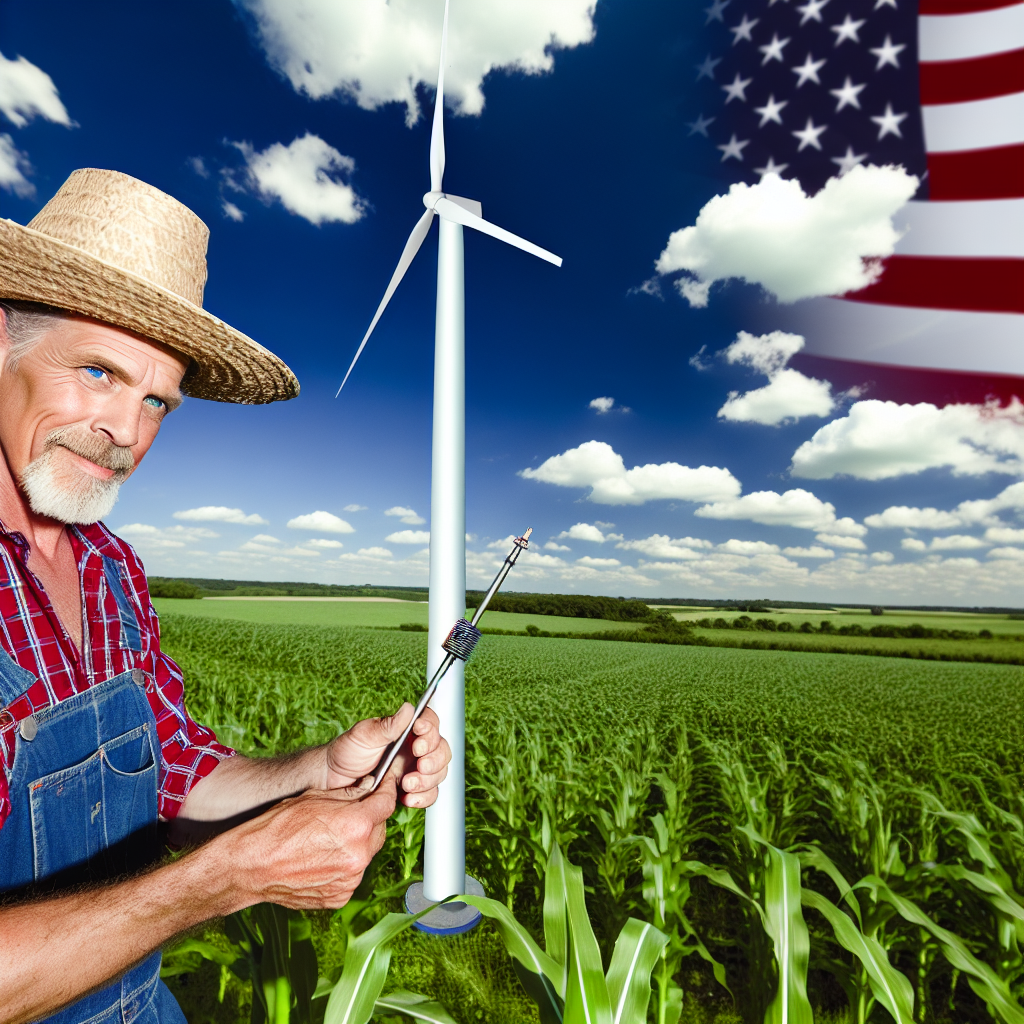
Regulatory Frameworks and Incentives for Wind Energy in Farming
Overview of Regulations
The regulatory landscape for wind energy varies by region.
Showcase Your Farming Business
Publish your professional farming services profile on our blog for a one-time fee of $200 and reach a dedicated audience of farmers and agribusiness owners.
Publish Your ProfileFarmers must navigate local, state, and federal regulations.
These regulations often dictate permitting and installation procedures.
Understanding these rules is crucial for compliance.
Moreover, regulations may change with evolving energy policies.
Incentives for Farmers
Various incentives exist to encourage wind energy adoption in agriculture.
These incentives can significantly reduce installation costs.
Federal tax credits motivate farmers to invest in wind technology.
State programs might offer additional financial support.
Exemptions from property taxes can also promote wind energy use.
Partnership Opportunities
Collaboration with private companies can enhance funding options.
Farmers should explore partnerships with renewable energy firms.
Such collaborations often involve shared investment in wind farms.
Additionally, cooperative initiatives can strengthen community efforts.
Environmental Impact Assessments
Environmental assessments are often required for wind projects.
These assessments evaluate potential impacts on local wildlife.
Farmers benefit from minimizing negative environmental effects.
Informed decision-making helps align projects with sustainable practices.
Future of Regulatory Frameworks
As wind energy technology evolves, regulations may adapt.
Potential new policies could make wind energy even more accessible.
Reviewing emerging regulations can benefit forward-thinking farmers.
Lastly, participating in advocacy can influence future legislation.
Discover More: Rainwater Harvesting Tips for Enhanced Farm Water Use
Future Trends in Wind Energy Solutions for Sustainable Agriculture
Innovative Wind Turbine Designs
New aerodynamic turbine designs enhance energy capture efficiency.
They are now smaller and more effective for farms with limited space.
Additionally, vertical-axis wind turbines are gaining popularity.
These designs reduce noise pollution and land use impact.
Integration with Smart Farming Technologies
Farmers are increasingly using smart technologies in agriculture.
Integrating wind energy solutions with IoT devices maximizes efficiency.
This integration allows for real-time energy monitoring and management.
Smart sensors can optimize turbine operation based on environmental conditions.
Government Incentives and Support
Many governments are offering incentives for renewable energy adoption.
Subsidies for wind energy installations are becoming more common.
These financial supports help farmers transition to sustainable solutions.
Furthermore, grants for research into innovative wind technologies are available.
Community Wind Projects
Community-based wind energy projects are on the rise.
These initiatives allow farmers to share resources and costs.
They foster collaboration and enhance local energy security.
Additionally, shared projects can lead to economic benefits for the community.
Resilience to Climate Change
Wind energy solutions contribute to climate resilience in agriculture.
Farmers can use wind power to reduce dependency on fossil fuels.
Showcase Your Farming Business
Publish your professional farming services profile on our blog for a one-time fee of $200 and reach a dedicated audience of farmers and agribusiness owners.
Publish Your ProfileThis transition helps mitigate the impacts of climate change.
Moreover, renewable energy enhances long-term sustainability in farming.
The Role of Wind Energy in the Future of Farming
Integrating Wind Energy into Agricultural Practices
Wind energy plays a crucial role in modern agriculture.
Farmers can harness wind energy for various applications.
This integration helps reduce dependence on non-renewable sources.
Moreover, it enhances the overall sustainability of farming operations.
Benefits of Wind Energy in Agriculture
Utilizing wind energy offers multiple advantages.
It significantly lowers energy costs for farmers.
Additionally, wind energy contributes to environmental conservation.
Farmers can also benefit from government incentives for renewable energy.
As a result, they can improve their profitability while being eco-friendly.
Technological Advancements in Wind Energy
Recent technological developments have made wind energy more accessible.
Innovations in turbine design increase efficiency and reduce maintenance.
Furthermore, advancements in energy storage systems enhance reliability.
These improvements create more opportunities for farmers to invest in wind energy.
Community Impact and Collaboration
Wind energy projects can positively impact local communities.
Farmers can collaborate with renewable energy companies.
This collaboration leads to shared benefits and resources.
Additionally, community wind farms can empower rural areas economically.
Adopting a Resilient Farming Model
Incorporating wind energy strengthens the resilience of farming operations.
Farmers who utilize wind energy can better adapt to climate challenges.
This adaptability ensures long-term sustainability in food production.
Ultimately, farmers create a more secure future for their families and communities.
Additional Resources
Wind Energy’s Potential Effects on Wildlife and the … – WINDExchange

